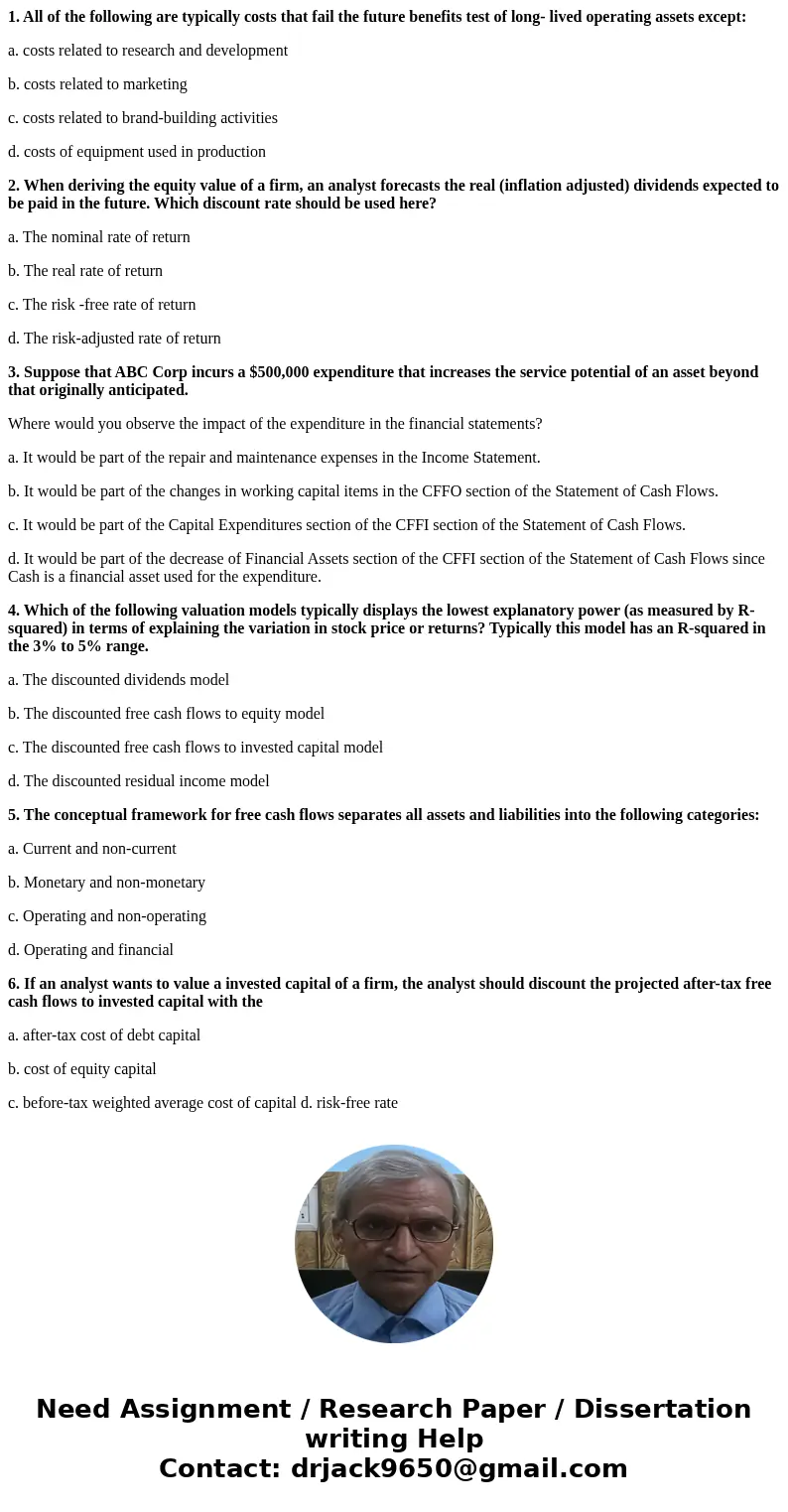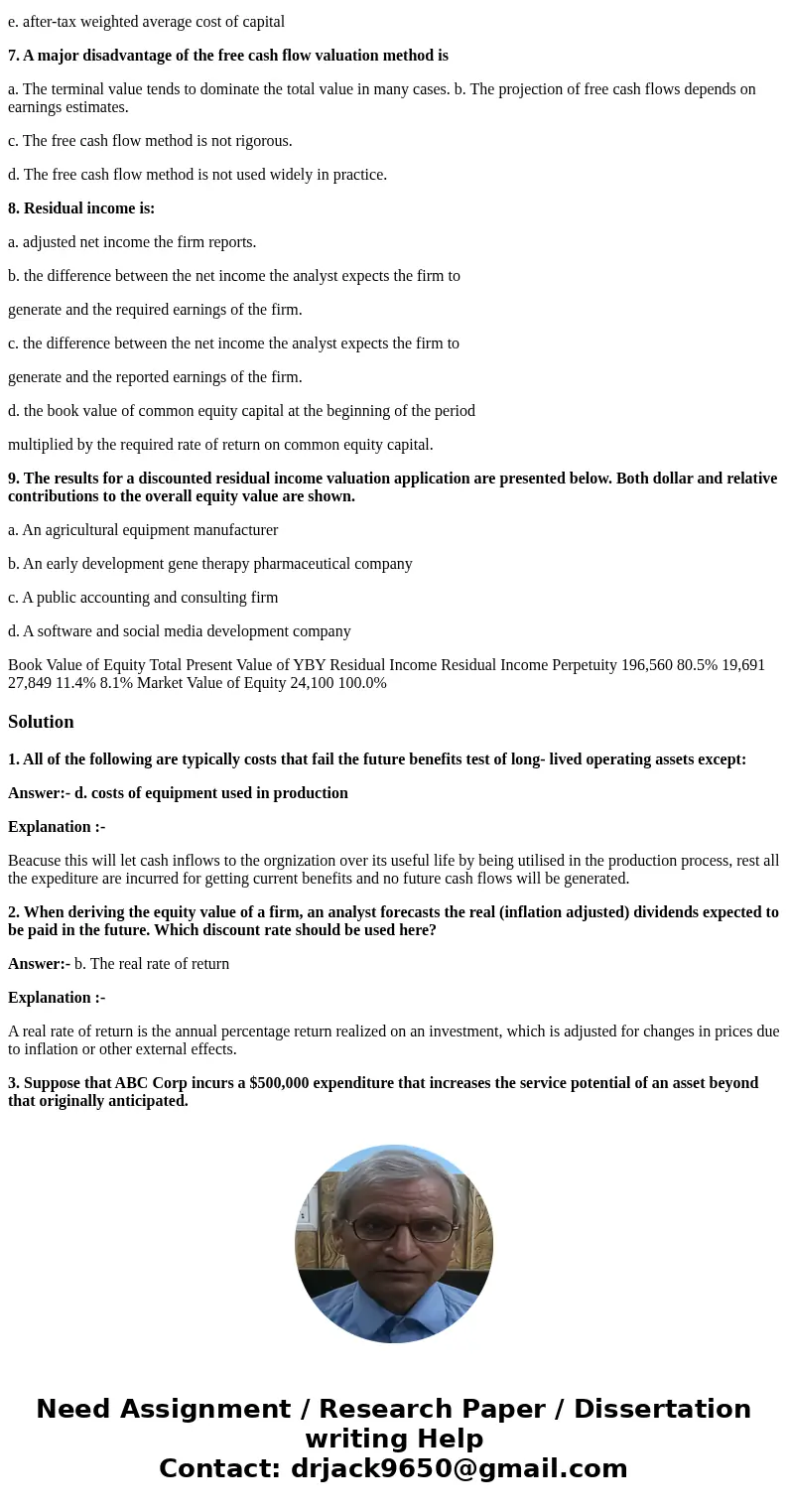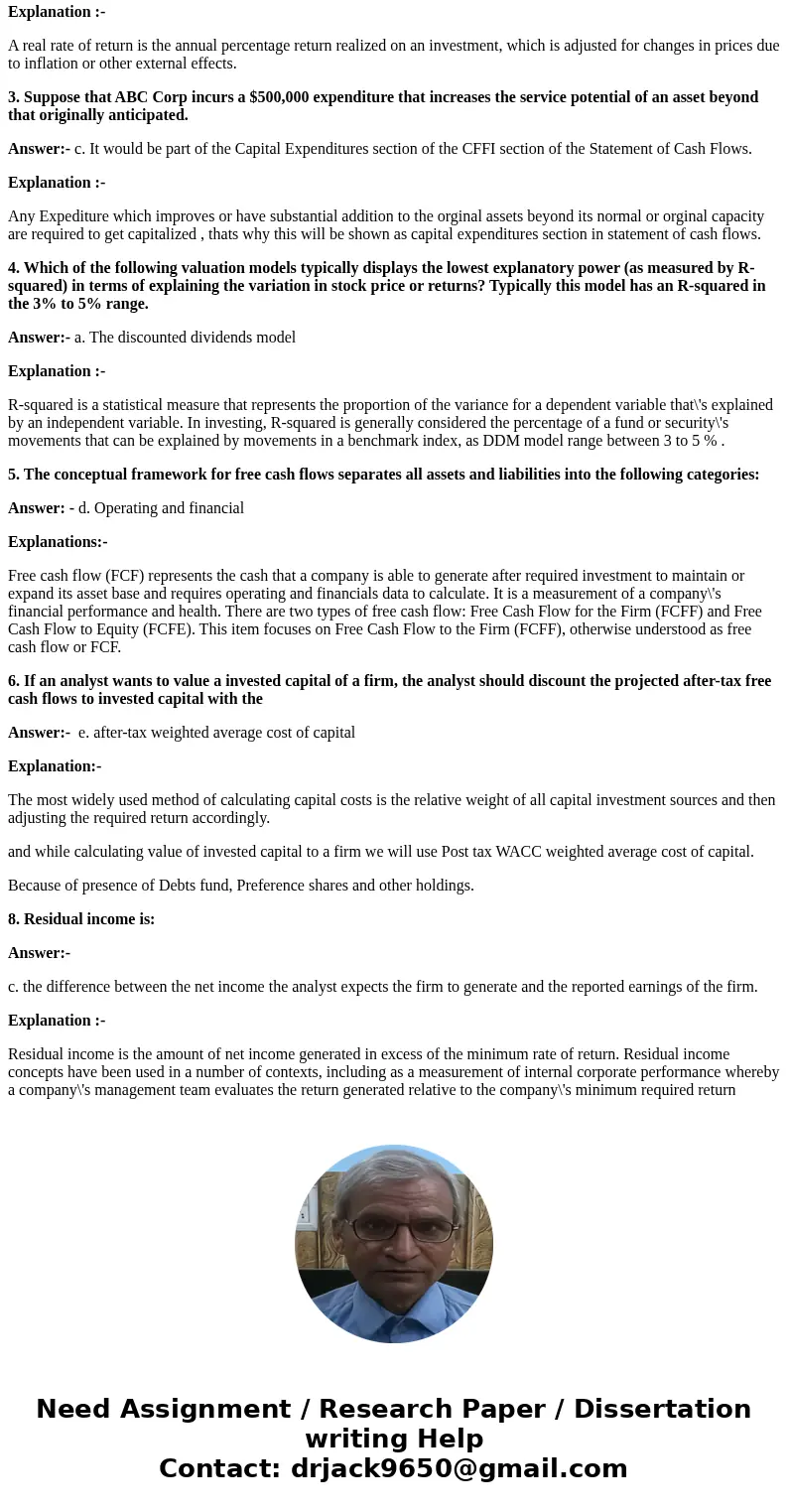1 All of the following are typically costs that fail the fut
1. All of the following are typically costs that fail the future benefits test of long- lived operating assets except:
a. costs related to research and development
b. costs related to marketing
c. costs related to brand-building activities
d. costs of equipment used in production
2. When deriving the equity value of a firm, an analyst forecasts the real (inflation adjusted) dividends expected to be paid in the future. Which discount rate should be used here?
a. The nominal rate of return
b. The real rate of return
c. The risk -free rate of return
d. The risk-adjusted rate of return
3. Suppose that ABC Corp incurs a $500,000 expenditure that increases the service potential of an asset beyond that originally anticipated.
Where would you observe the impact of the expenditure in the financial statements?
a. It would be part of the repair and maintenance expenses in the Income Statement.
b. It would be part of the changes in working capital items in the CFFO section of the Statement of Cash Flows.
c. It would be part of the Capital Expenditures section of the CFFI section of the Statement of Cash Flows.
d. It would be part of the decrease of Financial Assets section of the CFFI section of the Statement of Cash Flows since Cash is a financial asset used for the expenditure.
4. Which of the following valuation models typically displays the lowest explanatory power (as measured by R-squared) in terms of explaining the variation in stock price or returns? Typically this model has an R-squared in the 3% to 5% range.
a. The discounted dividends model
b. The discounted free cash flows to equity model
c. The discounted free cash flows to invested capital model
d. The discounted residual income model
5. The conceptual framework for free cash flows separates all assets and liabilities into the following categories:
a. Current and non-current
b. Monetary and non-monetary
c. Operating and non-operating
d. Operating and financial
6. If an analyst wants to value a invested capital of a firm, the analyst should discount the projected after-tax free cash flows to invested capital with the
a. after-tax cost of debt capital
b. cost of equity capital
c. before-tax weighted average cost of capital d. risk-free rate
e. after-tax weighted average cost of capital
7. A major disadvantage of the free cash flow valuation method is
a. The terminal value tends to dominate the total value in many cases. b. The projection of free cash flows depends on earnings estimates.
c. The free cash flow method is not rigorous.
d. The free cash flow method is not used widely in practice.
8. Residual income is:
a. adjusted net income the firm reports.
b. the difference between the net income the analyst expects the firm to
generate and the required earnings of the firm.
c. the difference between the net income the analyst expects the firm to
generate and the reported earnings of the firm.
d. the book value of common equity capital at the beginning of the period
multiplied by the required rate of return on common equity capital.
9. The results for a discounted residual income valuation application are presented below. Both dollar and relative contributions to the overall equity value are shown.
a. An agricultural equipment manufacturer
b. An early development gene therapy pharmaceutical company
c. A public accounting and consulting firm
d. A software and social media development company
Book Value of Equity Total Present Value of YBY Residual Income Residual Income Perpetuity 196,560 80.5% 19,691 27,849 11.4% 8.1% Market Value of Equity 24,100 100.0%Solution
1. All of the following are typically costs that fail the future benefits test of long- lived operating assets except:
Answer:- d. costs of equipment used in production
Explanation :-
Beacuse this will let cash inflows to the orgnization over its useful life by being utilised in the production process, rest all the expediture are incurred for getting current benefits and no future cash flows will be generated.
2. When deriving the equity value of a firm, an analyst forecasts the real (inflation adjusted) dividends expected to be paid in the future. Which discount rate should be used here?
Answer:- b. The real rate of return
Explanation :-
A real rate of return is the annual percentage return realized on an investment, which is adjusted for changes in prices due to inflation or other external effects.
3. Suppose that ABC Corp incurs a $500,000 expenditure that increases the service potential of an asset beyond that originally anticipated.
Answer:- c. It would be part of the Capital Expenditures section of the CFFI section of the Statement of Cash Flows.
Explanation :-
Any Expediture which improves or have substantial addition to the orginal assets beyond its normal or orginal capacity are required to get capitalized , thats why this will be shown as capital expenditures section in statement of cash flows.
4. Which of the following valuation models typically displays the lowest explanatory power (as measured by R-squared) in terms of explaining the variation in stock price or returns? Typically this model has an R-squared in the 3% to 5% range.
Answer:- a. The discounted dividends model
Explanation :-
R-squared is a statistical measure that represents the proportion of the variance for a dependent variable that\'s explained by an independent variable. In investing, R-squared is generally considered the percentage of a fund or security\'s movements that can be explained by movements in a benchmark index, as DDM model range between 3 to 5 % .
5. The conceptual framework for free cash flows separates all assets and liabilities into the following categories:
Answer: - d. Operating and financial
Explanations:-
Free cash flow (FCF) represents the cash that a company is able to generate after required investment to maintain or expand its asset base and requires operating and financials data to calculate. It is a measurement of a company\'s financial performance and health. There are two types of free cash flow: Free Cash Flow for the Firm (FCFF) and Free Cash Flow to Equity (FCFE). This item focuses on Free Cash Flow to the Firm (FCFF), otherwise understood as free cash flow or FCF.
6. If an analyst wants to value a invested capital of a firm, the analyst should discount the projected after-tax free cash flows to invested capital with the
Answer:- e. after-tax weighted average cost of capital
Explanation:-
The most widely used method of calculating capital costs is the relative weight of all capital investment sources and then adjusting the required return accordingly.
and while calculating value of invested capital to a firm we will use Post tax WACC weighted average cost of capital.
Because of presence of Debts fund, Preference shares and other holdings.
8. Residual income is:
Answer:-
c. the difference between the net income the analyst expects the firm to generate and the reported earnings of the firm.
Explanation :-
Residual income is the amount of net income generated in excess of the minimum rate of return. Residual income concepts have been used in a number of contexts, including as a measurement of internal corporate performance whereby a company\'s management team evaluates the return generated relative to the company\'s minimum required return



 Homework Sourse
Homework Sourse